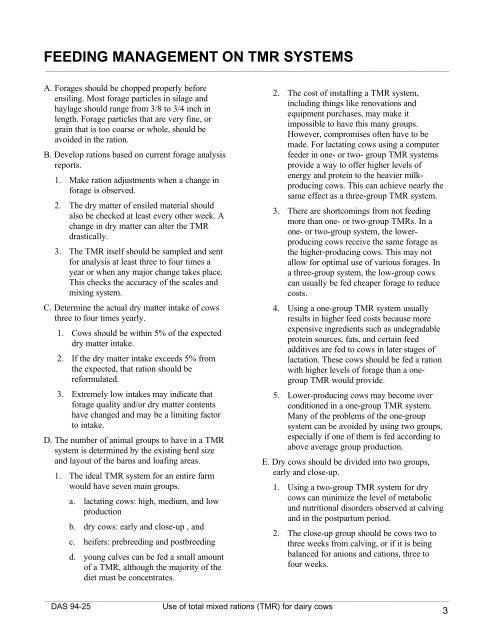Use of total mixed rations (TMR) for dairy cows - Penn State ...
Use of total mixed rations (TMR) for dairy cows - Penn State ...
Use of total mixed rations (TMR) for dairy cows - Penn State ...
You also want an ePaper? Increase the reach of your titles
YUMPU automatically turns print PDFs into web optimized ePapers that Google loves.
FEEDING MANAGEMENT ON <strong>TMR</strong> SYSTEMS<br />
__________________________________________________________________________________________________________________________________<br />
A. Forages should be chopped properly be<strong>for</strong>e<br />
ensiling. Most <strong>for</strong>age particles in silage and<br />
haylage should range from 3/8 to 3/4 inch in<br />
length. Forage particles that are very fine, or<br />
grain that is too coarse or whole, should be<br />
avoided in the ration.<br />
B. Develop <strong>rations</strong> based on current <strong>for</strong>age analysis<br />
reports.<br />
1. Make ration adjustments when a change in<br />
<strong>for</strong>age is observed.<br />
2. The dry matter <strong>of</strong> ensiled material should<br />
also be checked at least every other week. A<br />
change in dry matter can alter the <strong>TMR</strong><br />
drastically.<br />
3. The <strong>TMR</strong> itself should be sampled and sent<br />
<strong>for</strong> analysis at least three to four times a<br />
year or when any major change takes place.<br />
This checks the accuracy <strong>of</strong> the scales and<br />
mixing system.<br />
C. Determine the actual dry matter intake <strong>of</strong> <strong>cows</strong><br />
three to four times yearly.<br />
1. Cows should be within 5% <strong>of</strong> the expected<br />
dry matter intake.<br />
2. If the dry matter intake exceeds 5% from<br />
the expected, that ration should be<br />
re<strong>for</strong>mulated.<br />
3. Extremely low intakes may indicate that<br />
<strong>for</strong>age quality and/or dry matter contents<br />
have changed and may be a limiting factor<br />
to intake.<br />
D. The number <strong>of</strong> animal groups to have in a <strong>TMR</strong><br />
system is determined by the existing herd size<br />
and layout <strong>of</strong> the barns and loafing areas.<br />
1. The ideal <strong>TMR</strong> system <strong>for</strong> an entire farm<br />
would have seven main groups.<br />
a. lactating <strong>cows</strong>: high, medium, and low<br />
production<br />
b. dry <strong>cows</strong>: early and close-up , and<br />
c. heifers: prebreeding and postbreeding<br />
d. young calves can be fed a small amount<br />
<strong>of</strong> a <strong>TMR</strong>, although the majority <strong>of</strong> the<br />
diet must be concentrates.<br />
2. The cost <strong>of</strong> installing a <strong>TMR</strong> system,<br />
including things like renovations and<br />
equipment purchases, may make it<br />
impossible to have this many groups.<br />
However, compromises <strong>of</strong>ten have to be<br />
made. For lactating <strong>cows</strong> using a computer<br />
feeder in one- or two- group <strong>TMR</strong> systems<br />
provide a way to <strong>of</strong>fer higher levels <strong>of</strong><br />
energy and protein to the heavier milkproducing<br />
<strong>cows</strong>. This can achieve nearly the<br />
same effect as a three-group <strong>TMR</strong> system.<br />
3. There are shortcomings from not feeding<br />
more than one- or two-group <strong>TMR</strong>s. In a<br />
one- or two-group system, the lowerproducing<br />
<strong>cows</strong> receive the same <strong>for</strong>age as<br />
the higher-producing <strong>cows</strong>. This may not<br />
allow <strong>for</strong> optimal use <strong>of</strong> various <strong>for</strong>ages. In<br />
a three-group system, the low-group <strong>cows</strong><br />
can usually be fed cheaper <strong>for</strong>age to reduce<br />
costs.<br />
4. Using a one-group <strong>TMR</strong> system usually<br />
results in higher feed costs because more<br />
expensive ingredients such as undegradable<br />
protein sources, fats, and certain feed<br />
additives are fed to <strong>cows</strong> in later stages <strong>of</strong><br />
lactation. These <strong>cows</strong> should be fed a ration<br />
with higher levels <strong>of</strong> <strong>for</strong>age than a onegroup<br />
<strong>TMR</strong> would provide.<br />
5. Lower-producing <strong>cows</strong> may become over<br />
conditioned in a one-group <strong>TMR</strong> system.<br />
Many <strong>of</strong> the problems <strong>of</strong> the one-group<br />
system can be avoided by using two groups,<br />
especially if one <strong>of</strong> them is fed according to<br />
above average group production.<br />
E. Dry <strong>cows</strong> should be divided into two groups,<br />
early and close-up.<br />
1. Using a two-group <strong>TMR</strong> system <strong>for</strong> dry<br />
<strong>cows</strong> can minimize the level <strong>of</strong> metabolic<br />
and nutritional disorders observed at calving<br />
and in the postpartum period.<br />
2. The close-up group should be <strong>cows</strong> two to<br />
three weeks from calving, or if it is being<br />
balanced <strong>for</strong> anions and cations, three to<br />
four weeks.<br />
_____________________________________________________________________________________________________________________________________________________<br />
DAS 94-25 <strong>Use</strong> <strong>of</strong> <strong>total</strong> <strong>mixed</strong> <strong>rations</strong> (<strong>TMR</strong>) <strong>for</strong> <strong>dairy</strong> <strong>cows</strong><br />
3



